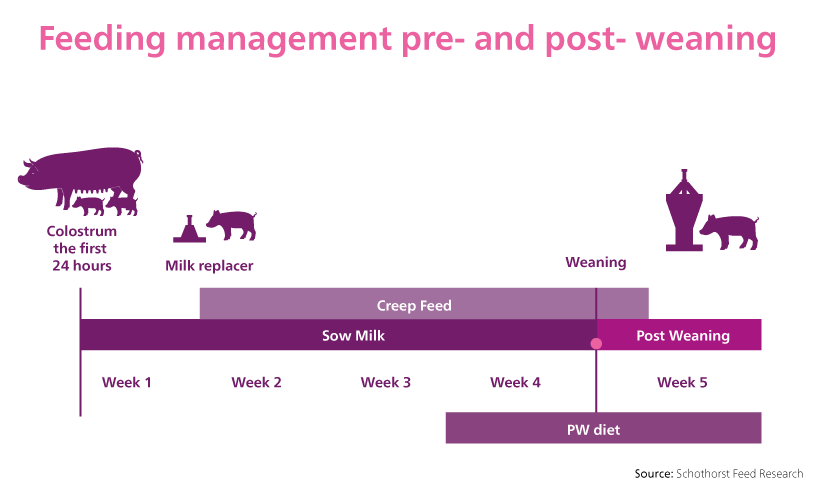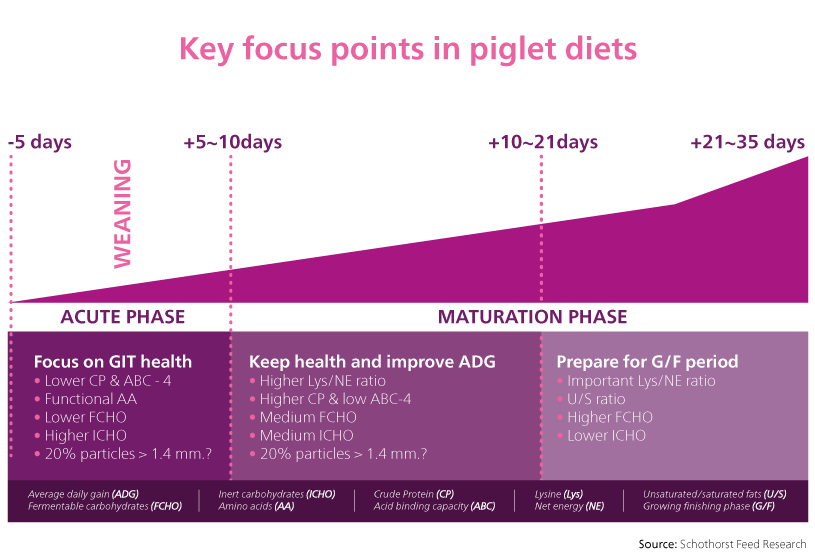Feeding strategies can be sustainable and profitable when raising piglets without zinc oxide
Interview with Dr. Francesc Molist
Weaning is an important but highly stressful time for piglets. Several stressors put huge pressure on their digestive and immune systems making piglets vulnerable to diseases, like post-weaning diarrhea (PWD).
Zinc oxide (ZnO) has been successfully used as a cost-effective solution of mitigating PWD for many years. But in 2017, the European Commission supported a decision by the European Medicines Agency to move away from using pharmacological doses of ZnO in piglets’ feeds. Because the benefit of using ZnO does not outweigh the negative environmental impact and the associated risk of increasing antimicrobial resistance bacteria.
This new context demands for alternative solutions to prevent PWD and maintain the piglet’s health status during weaning. A multifaceted approach needs to be taken which incorporates biosecurity, health care, management, and nutrition.
Join us in this interview with DVM, PhD, BBS Francesc Molist, Research & Development manager at Schothorst Feed Research (Netherlands) where we discuss new nutritional approaches when feeding piglets after the ZnO ban and give useful advice for pig producers to maintain a sustainable and profitable production during these new times.
Dr. Francesc Molist is a veterinarian and specialist in pig nutrition, R&D Manager at the "Schothorst Feed Investigation" (The Netherlands) since 2017. Molist completed his Master's and Doctorate at the Faculty of Veterinary Medicine of the Autonomous University of Barcelona, in Spain. In 2011 he joined Schothorst Feed Investigation as a pig researcher and consultant and became the Head of the Pig Research Group in 2013. He is involved in research and providing independent consultancy for the pig feed industry. He is the author of several scientific publications, as well as articles, magazines and conferences.
Dr. Molist, what impact do you think the removal of ZnO will have on the composition and cost of piglet diets?
ZnO was the cheapest solution that we had available in the field along with antibiotics. Is there a solution as cost-effective as ZnO or antibiotic growth promoters? No, and the consequence is that the production cost will likely go up. One of the positive sides of this ban is an opportunity for the sector to professionalize and for the farms to do the right thing. In terms of productivity, you can adapt and you can benefit.
ZnO was helping with achieving a good production in a bad environment. Now without ZnO we can see that this safety margin is gone, that means that you really need to be more critical with the feed you provide, but also be very aware of management, ventilation, water quality, etc. You need a holistic approach and also to pay more attention than ever to production, we need to be closer to the farm to understand every situation in order to find tailored solutions for each scenario.
Also, feed wise, this will change the way several companies have been working because in the past there were big integrators with one single piglet feed range in its portfolio. The future is not anymore “one range to all customers”. My recommendation would be to differentiate feeds, at least two. For example, a safety range for producers that have more challenges and one regular production range. This means that inside the feed mill you need more customization and specifications and also deal with more raw materials and diets, which will probably increase the feed production costs.
If you’re having more challenged farms that need extra attention on feed quality, feed composition, feed ingredients, etc. What would be your golden rule when formulating feeds for these farms?
First, the feed needs to be the right one. Crude protein will play a big role so it needs to be of a good quality to reduce protein fermentation.
In most countries, crude protein is a result of the level of lysine that you want to use. If you want a high lysine level then you will have more crude protein and the opposite also applies. So, in many cases, we need to check if levels between 12-14 grams SID Lys, which have been used in the past, are still valid, or if around weaning we should lower the lysine level. Pushing the animal digestion will bring health problems. There’s a need to build a diet that will help the animal adapt to the weaning challenges, and only when the animal has adapted to the new weaning situation is when we can push growth. You need to pay attention to the animal to see if it can digest properly in order to avoid diarrhea.

How should you work with carbohydrate sources?
In the first stage, sugars and starch are good energy sources for the piglets. Work with low levels of fermentable fiber, it can be used to shape the intestinal microbiome which is not yet established, so you have the opportunity to modulate it by the quality of fiber that you give, what we call prebiotics. But if you exceed this fermentation capacity then you get dysbiosis, and diarrhea as a consequence.
So, try to limit the fermentable fiber and focus more on low fermentable or inert fiber, which will have more effect on transit time so digestion won’t stop and won’t let harmful bacteria proliferate. As the piglets’ GI tract matures you can gradually increase the fermentable fibers in the diet.

Immature animals are not quite set to digest fat. What do you have to say about this nutrient group?
The role of fat is linked to the energy levels. In these early diets try to use as much energy as you can coming from starch and sugars and try to limit the fats as much as you can. Having high levels of fat in weaner diets is not a good strategy, especially in farms where you have challenges, because fat digestibility is really compromised when there’s diarrhea, so animals will not grow.
Many nutritionists right now are not paying attention to the Omega-3 and Omega-6 ratio. So far, we focus on emulsifiers but no so much on fat as a nutrient. In the coming years we need to better understand what type of fat do we want to have in the weaning diets?
Do we need to consider the feed buffer capacity when feeding piglets?
Young animals need quite a lot of protein and minerals and at the same time those elements increase the buffer capacity of the feed and also then buffer the stomach it goes in to. So, it helps to acidify the feed to reduce the buffer capacity. Focus on the intestine is good but we need to focus on the stomach and its gastric barrier first. If the stomach is not working properly, you can try and focus in the intestine, but the results won’t be good. Gut health won’t be successful.
The buffering in the stomach should be under control to avoid damage to the acid gastric barrier. If this is not working E. coli, Salmonella or Clostridium can colonize.
Do you want to know more about Perstorp’s solutions to raise piglets without ZnO? Click here
Do you have any advice on what is the best physical form of the diet for piglets?
This is the one of the areas where we’ll do more research in the next years. Creep feed, have been formulated to have small pellets, because piglets are small. In the future we will see how can we stimulate feed intake. There’re some trials in The Netherlands already where we are testing that if piglets see bigger pellets, they get more triggered to explore that feed.
We need to understand the effects of physical form of the feed but also on the nutrient density. Solid feed or solid material in the intestines accelerate maturation of the gut and its digestive capacity. In the weaning stage, feed intake needs to be stimulated as much as we can without exceeding the digestive capacity and the only way to do this is by diluting the diets. Energy levels will go down as a consequence too, if energy goes down, then you stimulate feed intake.
You must start slow. When piglets are with the sow, my advice is to challenge the gut a little with solid feed along with the milk, so that the gut gets used to starches and fiber and matures faster, so weaning will be easier on the animal. In the past we used to do a lot of the work post weaning but now, we need to start our intervention pre weaning. Starting post weaning might be too late, you can’t change the microbiota or the immunity on this stage. The idea is to make the link pre- and post-weaning stages so you don’t change the animal’s environment and feed at the same time, because that brings a lot of stress to the piglet. Keep the same diet pre- and post-weaning, and offer the post weaning diet during the lactation period. This simple strategy will benefit the animal immensely as they will be familiar to this diet, and will continue to eat it during weaning.
What’s your advice with water destined for piglets?
Water is the forgotten nutrient. You need to understand the quality of the water. You can have the best feed quality but your water could be carrying numerous pathogens. Also, water can have quite a bit of buffering capacity, depending how hard the water is, how much limestone there is, etc. In the future, matching the water intake with the feed intake in piglets and also the sows will be really important. Without ZnO, when you have problems, you need to consider checking your water too, instead of getting a new feed strategy and re-evaluating all again. Nutritionist are responsible for the feed and also the water. Feed alone will not solve the problem alone, for sure.
Usually, when animals are sick, or they have diarrhea, they will not eat, but they will drink. In those farms where you have diarrhea and there is always a challenge then you can think about acidify water or do treatments by water. But you have to make sure to follow protocols because vitamins and supplements administered via the water can may increase biofilm formation and bacterial growth. Water needs to have a pH of 3.5-4, water lines need to be cleaned and biofilm removed.
How do you foresee the future of pig production in general?
It’s going to be back to basics. The feed industry is changing a lot. Mainly because of carbon footprint and circularity and more attention to the welfare of the animals. There will also be competition between what can be fed to pigs and what can be used to feed humans and also more competition on food access. Looking more into this perspective, pigs will be fed more by-products in the future. Pigs are very efficient and can handle several of the by-products in their feeds since they are omnivores. We will not re-invent the wheel, we will be forced to understand how to use by-products like old farmers did in the past, like in the old days.
We need to find the balance between technology and innovation. We need to make sense on what it is better and be more transparent in what we are doing and how animals are being treated by being circular and respecting the environment while feeding the world.